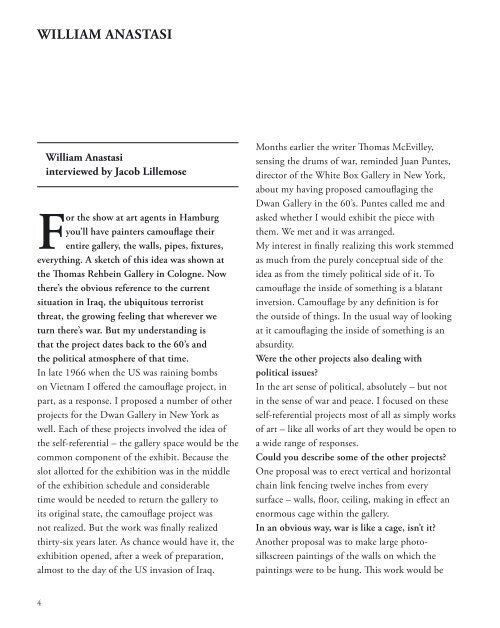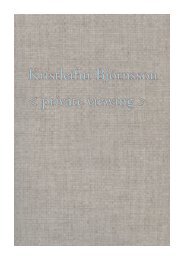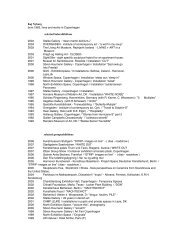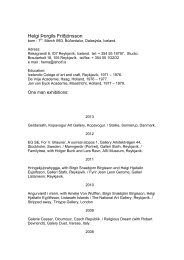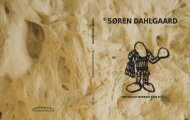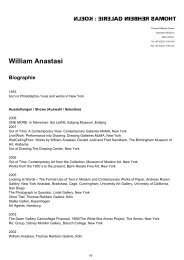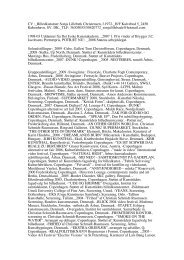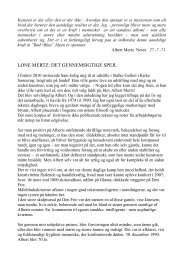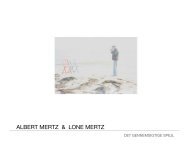William Anastasi - Stalke
William Anastasi - Stalke
William Anastasi - Stalke
Create successful ePaper yourself
Turn your PDF publications into a flip-book with our unique Google optimized e-Paper software.
WILLIAM ANASTASI<br />
<strong>William</strong> <strong>Anastasi</strong><br />
interviewed by Jacob Lillemose<br />
For the show at art agents in Hamburg<br />
you’ll have painters camouflage their<br />
entire gallery, the walls, pipes, fixtures,<br />
everything. A sketch of this idea was shown at<br />
the Thomas Rehbein Gallery in Cologne. Now<br />
there’s the obvious reference to the current<br />
situation in Iraq, the ubiquitous terrorist<br />
threat, the growing feeling that wherever we<br />
turn there’s war. But my understanding is<br />
that the project dates back to the 60’s and<br />
the political atmosphere of that time.<br />
In late 1966 when the US was raining bombs<br />
on Vietnam I offered the camouflage project, in<br />
part, as a response. I proposed a number of other<br />
projects for the Dwan Gallery in New York as<br />
well. Each of these projects involved the idea of<br />
the self-referential – the gallery space would be the<br />
common component of the exhibit. Because the<br />
slot allotted for the exhibition was in the middle<br />
of the exhibition schedule and considerable<br />
time would be needed to return the gallery to<br />
its original state, the camouflage project was<br />
not realized. But the work was finally realized<br />
thirty-six years later. As chance would have it, the<br />
exhibition opened, after a week of preparation,<br />
almost to the day of the US invasion of Iraq.<br />
Months earlier the writer Thomas McEvilley,<br />
sensing the drums of war, reminded Juan Puntes,<br />
director of the White Box Gallery in New York,<br />
about my having proposed camouflaging the<br />
Dwan Gallery in the 60’s. Puntes called me and<br />
asked whether I would exhibit the piece with<br />
them. We met and it was arranged.<br />
My interest in finally realizing this work stemmed<br />
as much from the purely conceptual side of the<br />
idea as from the timely political side of it. To<br />
camouflage the inside of something is a blatant<br />
inversion. Camouflage by any definition is for<br />
the outside of things. In the usual way of looking<br />
at it camouflaging the inside of something is an<br />
absurdity.<br />
Were the other projects also dealing with<br />
political issues<br />
In the art sense of political, absolutely – but not<br />
in the sense of war and peace. I focused on these<br />
self-referential projects most of all as simply works<br />
of art – like all works of art they would be open to<br />
a wide range of responses.<br />
Could you describe some of the other projects<br />
One proposal was to erect vertical and horizontal<br />
chain link fencing twelve inches from every<br />
surface – walls, floor, ceiling, making in effect an<br />
enormous cage within the gallery.<br />
In an obvious way, war is like a cage, isn’t it<br />
Another proposal was to make large photosilkscreen<br />
paintings of the walls on which the<br />
paintings were to be hung. This work would be<br />
CAMOUFLAGE | 1966/2003<br />
4 5


